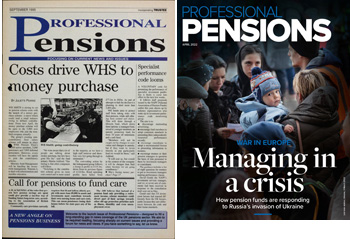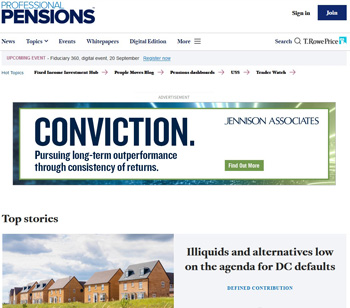
The story of Incisive Media’s Professional Pensions is one that is familiar to many brands in the business-to-business publishing space.
The specialist title – aimed at the professionals and trustees that run and oversee workplace pension funds – was launched by MSM International as a monthly print title in 1995 to serve what was then a long-standing gap in the coverage of the UK pensions sector.
As with many such titles, the brand developed quickly, both in terms of content and in terms of brand extensions, such as conferences, shows and award programmes. In 1997, Professional Pensions launched the UK Pensions Awards and the magazine went weekly on the back of rising recruitment and display advertising. Soon afterwards, the brand set up its flagship tradeshow, The Pensions Show, an event which continues to this day under the Professional Pensions Live branding. A website as well as a growing stable of conferences and award shows soon followed and the brand was acquired by Incisive Media in 2006.
The challenges facing the publication from the global financial crisis were also felt by many – with the brand facing a steady decline in print recruitment and display advertising. Professional Pensions, like other media brands, made up the shortfall (and indeed grew the brand) through the continuing development of its digital and events offerings.
Yet, while the B2B world was becoming increasingly digital, Professional Pensions’ audience of trustees – who tend to represent a slightly older demographic – were still keen to receive a print edition, even though their preferences for frequency was changing.
In 2019, Professional Pensions conducted research among its readers – research that showed the preferences of the brand’s print audience had changed, with the majority saying they would prefer a more in-depth, monthly publication rather than the existing weekly magazine.
A major redesign followed with PP enlisting the help of award-winning creative director and design leader Andy Cowles to create a refreshed brand identity as well as a new-look monthly magazine.
Covid
The first issue of the new-look monthly was published at the beginning of March 2020 – just before the start of the pandemic – but it soon became clear the trend away from print among both Professional Pensions readers and the brand’s sponsors appeared to accelerate also as Covid-19 started to take hold and the national lockdowns began.

Incisive Media managing director for financial services and sustainability Kevin Sinclair – the publisher responsible for Professional Pensions – says the brand’s print products have been under review for a while, largely because of falling advertising revenues but also because of the move of readers away from wanting to receive a printed weekly or monthly digest. He notes sustainability has been a key consideration also.
But he agrees the pandemic accelerated the trend away from print among both the readers and the brand’s sponsors too.
Despite this, Sinclair says the business didn’t immediately decide to exit print – deciding instead to wait until the crisis was beginning to ease before taking any action.
He says: “Once the pandemic was starting to lift, and people were heading back into the office, we decided we would continue publishing magazines for a while longer to give ourselves an opportunity to judge whether the trend away from print would continue, post lockdown.
“On reflection we found that both those trends continued – there was both a lack of support from our advertisers and our readers were increasingly telling us they didn’t want to receive a printed monthly digest. This feedback is ultimately why we chose to stop publishing our print products at the end of quarter one this year.”
Other changes
Sinclair says other trends also accelerated through the pandemic and contributed to the shift away from print – notably that sales and marketing teams within the markets Incisive Media serves were increasingly working together more closely, something that drove changes in the way they spent money with publishers.
He says: “During the pandemic, the ability to physically meet and talk to clients was removed from sales teams who turned to their colleagues in marketing to help make these connections.
“That closer working relationship continued after the pandemic and the influence that sales teams have had on marketing has led to a greater desire for obvious return on investment, for what I would call actionable response, the ability to analyse how your marketing campaigns have performed.”
Sinclair added: “Sadly, print advertising doesn’t give you that information and therefore the products that we’re starting to see more interest in are predominantly digital and more around lead generation. Account-based marketing is starting to find its way into the conversations we are having.
“The direction of travel is there – it has to be digital or events, because the attribution of response is very obvious, and you can measure it.”
Half-way house
As Sinclair says, Incisive ultimately took the decision to close both of its remaining print products – both Professional Pensions and its weekly sister title Investment Week – at the same time.
But why did Incisive Media decide to cease publishing Professional Pensions’ print edition completely rather than changing to a different frequency or shifting to solely e-zine delivery?
Sinclair says there were two reasons behind the move.
He says: “I thought that to move to, say, a quarterly format would signify a death by 1,000 cuts, like we were just putting off the inevitable – if we believe in a direction of travel, we believe that our sponsors, our partners, and our audience are all moving in a certain way, then why not make that decision either as they’re making it or, if possible, slightly ahead of them.”
The second thing Sinclair noted was that closing print enabled the brand to free up journalistic resource to work on other things – noting neither brand affected has lost any journalists through the process of closing print.
But he said that reducing the frequency of the magazine or moving 100% to a digital ezine wouldn’t have really removed any of the editorial resource spent on delivering it.
Sinclair explains: “I was keen to be able to take that cycle of putting together a regular magazine away from the editorial team to allow them to truly focus their efforts on creating content for the digital world, as well as leading our event delivered content as well.”
Life after print
Incisive Media already has substantial plans for growth – with its brands in the financial services space, including Professional Pensions, looking to launch a new site, Investment IQ, to cover both the institutional and wholesale asset management markets.

“This is a site where we host content on behalf of our partners. Every single piece of content we host will be marketed and get its own distribution campaign – we can then pass on information to our clients about who is downloading, who’s reading and who’s watching their content.”
Sinclair says the brand can then work with its sponsors to create further activations. He explains: “Once a piece of content has received a volume of qualified downloads, we can then work with our client on the follow up message or call to action, potentially an invite to discuss the content further.”
This site will follow on from the launch of another new website, www.sustainable-investment.com earlier this year – a website that was developed off the back of Incisive’s Sustainable Investment Festival which was launched in 2021.
On Professional Pensions specifically, Sinclair is keen to grow its membership and is keen to see more of the brand’s audience become members and enjoy the benefits of that.
He says: “Gaining an even closer understanding of our audiences is certainly going to be a key driver for us over the next twelve months as well.”
Challenges
But while there are opportunities for brands such as Professional Pensions, there are also challenges, as Sinclair acknowledges.
The main challenge he sees is a perennial one for both journalists and publishers – making sure the brand continues to deliver its audience the content that they want to receive.
Sinclair explains: “The number of significantly influential people in our markets is getting smaller. Our job, as always, is to engage with them and that’s where great content comes in. That’s why we are supporting and investing in our journalists, with increased data tools, a new studio facility and ongoing training. We’re very proud of the journalistic heritage we’ve got both on Professional Pensions and in our other titles as well.
“It really starts with engagement of the audience. If we continue to get that right, there is an exciting future for all our brands.”
This article was first published in InPublishing magazine. If you would like to be added to the free mailing list to receive the magazine, please register here.












